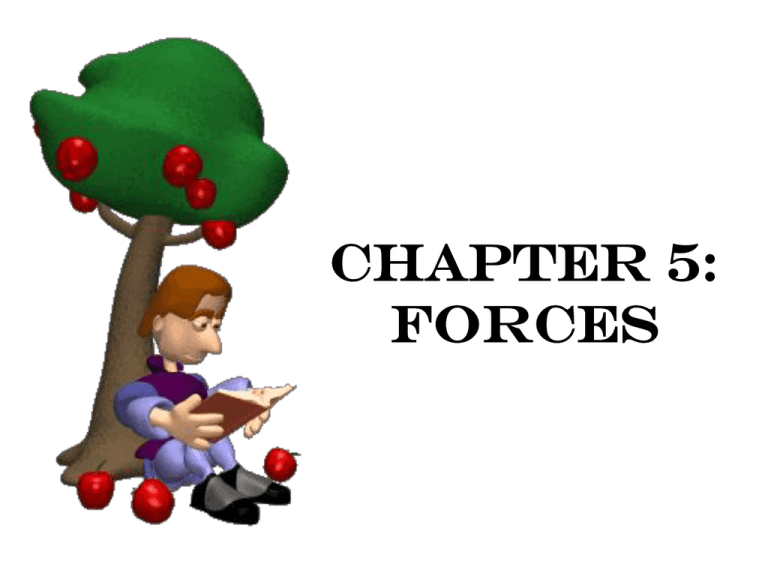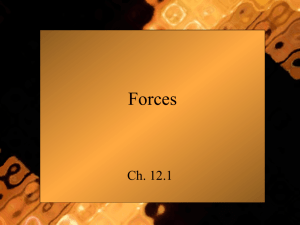Chapter 5 & 6: FORCES
advertisement

Chapter 5: forces I. What are forces? A. Characteristics: 1. Forces result from the interaction of objects. A FORCE is a push or a pull that one object exerts on another. 2. How are forces measured: a. in metric units Newtons (N) b. in English units pounds (lbs) (force of 1 lb = 4.448 N) 3. Forces are VECTORS (size & direction): - have positive values (e.g. +10N) when force is directed: up/North/right/East - have negative values (e.g. -10N) when force is directed: down/South/left/West - forces can be represented in diagrams by using arrows. (length = strength) (points in direction of the force) 4. Forces influence motion: - have the ability to change an object’s velocity (i.e. speed and direction) - Newton’s Laws of Motion 5. Forces are not always noticeable: - gravity pulls object’s toward earth - the ground pushes up on you 6. All forces are placed into TWO main categories: a. Contact Forces – those that result when two objects are in direct contact w/ each other. Examples… Applied Force – they push or pull Tension Elastic/Spring Friction Air Resistance Normal Force b. Action-through-space Forces (a.k.a. field forces – create a “force field”) – those that result even when two objects are not in direct contact w/ each other. Examples… Strong Nuclear – strongest force of all Electromagnetic Weak Force – related to radioactivity Gravitational II. Types of Forces The Contact Forces 1. Applied Force - a force that is applied to an object by a person or another object. 2. Tension Force - a force that is transmitted through a string rope, cable, or wire when it is “pulled” tight from opposite ends - the force is directed along the entire length of the rope and pulls equally on the objects on both ends 3. Spring Force - the force exerted by a spring upon the object that is compressing or stretching the spring - The spring will push/pull back on the object w/ a force that is needed to return the compressed/stretched spring to its resting position the magnitude of the force is proportional to the amount of stretch or compression Examples: A force of 16 N is required To stretch a spring a Distance of 40cm from its Rest position. What force is needed to stretch the spring: a)Twice the distance 32 N b)3x the distance 48 N c) Half the distance? 8 N 4. Gravitational Force (a.k.a. Weight) - the force w/ which a massively large object attracts another object toward itself - all objects on earth experience the force of gravity pulling them “downward” toward center of the earth. - on earth, gravity exerts a force of 9.8 N on every kg of mass, thus: the strength of gravity (g) = 9.8 N/kg - on the moon, the strength of gravity (g) is 1/6 that of earth (g = 1.6 N/kg) - the force of gravity is equal to the weight of an object - to calculate your weight, which is the force of gravity: Fgravity = m * g (where g = 9.8 N/kg) (weight) 1 kg W = 1(9.8) = 9.8 N 2 kg W = 2(9.8) = 19.6 N 3 kg W = 3(9.8) = 29.4 N - DON’T confuse mass and weight a. Mass – the amount of matter in an object measured in kg the same everywhere in the universe b. Weight – the force of gravity acting on an object’s mass (i.e. related to the pull of the earth) changes depending on location The Statue of Liberty has a mass of 225,000 kg. How much does she weigh? To calculate the weight of an object you have to multiply it’s mass times the acceleration of gravity. Write the formula: W = m * g Substitute known values: W = (225,000 kg) * 9.8 m/s² Present solution with units: W = 2,200,000 N What the heck is 2,200,000 N? The Statue of Liberty weighs 2,207,250 Newtons, which is 495,000 lbs pounds! - Example: An astronaut has a mass of 120 kg. a) what is his weight? b) what is his mass on the moon? c) what is his weight on the moon? Question: Can an object have mass but no weight when that object is located on earth? YES… - Remember Principles of Free Fall: when objects are in free fall, gravity will accelerate them toward the earth with a speed of 9.8 m/s2 when in free fall, an object has no weight W=0N weightlessness 5. Friction a. the force that opposes the motion of an object (i.e. acts in the opposite direction of motion). b. It results from two surfaces being pressed together c. friction depends on two things: 1. types of surface in contact; due to microscopic imperfections Example: puck on sandpaper = high friction puck on ice = low friction 2. amount of force pressing the surfaces together (more mass, more friction) Ffr Ffr d. Three general types of friction: - Static, Sliding, and Rolling 1. Static friction (greatest) - results when the surfaces of 2 objects are at rest; prevents an object from starting to move (static friction cancels out applied force). - eventually reach a point where applied force overcomes static friction and object will begin to move 2. Sliding friction - resists sliding motion of object across a dry surface - to keep an object moving, there must be another force present to overcome sliding force Remember: Static friction is much stronger than sliding friction. It is much harder to start an object moving than to keep an object moving 3. Rolling friction: - similar to sliding friction, but applies to objects that are rolling - example: tires rolling on the ground. e. Reducing friction: - Why? To decrease NRG loss (e.g. heat, noise) and to keep surfaces from wearing down. 1. Add lubricant b/n surfaces - puck slides on ice - oil in car engine 2. Reduce roughness of surfaces: - sanding wood 3. Ball bearings: - Two moving surfaces in a machine avoid direct contact by placing small metal balls b/n them. This way, sliding friction is changed to rolling friction. 4. Cushion of air or magnetic levitation: - air hockey - maglev trains 6. Air Resistance - the force that acts upon objects as they travel through air - most noticeable for object’s traveling at high speeds (e.g. skydiver) or large surface area - usually not taken into account b/c of its negligible magnitude 7. Normal Force (a.k.a. support force) - the force that a surface exerts on an object that is pressing on it. - it has an equal strength and opposite direction to the force pressing the object into the surface III. Forces and Equilibrium - Multiple forces are acting simultaneously on objects at all times A. Free-Body Diagrams - used to show the relative magnitude and direction of all forces acting upon objects - remember: size of arrow = magnitude tip of arrow = direction of force A free-body diagram illustrates the relative magnitude and direction of all forces acting upon an object. The object must be isolated and “free” of its surroundings. This is a free-body diagram of the Statue of Liberty. She is represented by a simple box. The forces acting on her are labeled with a magnitude and the arrow shows direction. Notice the surrounding objects are stripped away and the forces acting on the object are shown. 496210 lb 496210 lb “FW” : the force of the weight of the statue. “FN” : the normal force, which represents the force FW = 495,000 lb of the pedestal pushing back up on the statue. FN =495,000 lb Create a free body diagram (FBD) of the gorilla: FN Gorilla FW Free Body Diagram of the Sitting Gorilla (The box represents the gorilla, W = weight of the gorilla, N = Normal force) Sitting Gorilla Draw a FBD of the wooden swing: Where are the forces on the swing? FT1 FT2 Swing FW Free Body Diagram of the wooden swing (The box represents the wooden swing, W = weight of the swing and the parrot, T represents the ropes that are in tension supporting the weight) Parrot on wooden swing hung by ropes Draw a FBD of bucket the bungee jumper leaped from: Where are the forces on the bucket? FT bucket FW Free Body Diagram of the bucket (T represents the tensile force of the cable the bucket is suspended from, and W is the weight of the diver and the bucket) Bungee jumping from crane Draw a FBD of the ring at point C: Where are the forces on the ring? A B FTCA FTCB C D FTCD Traffic Light supported by cables Free Body Diagram of the ring at point C (T represents the force of the cables that are in tension acting on the ring) Draw a FBD of the traffic light: A B C Where are the forces on the light? FTCD Light D FW Traffic Light supported by cables Free Body Diagram of the traffic light (FTCD represents the force of the cables acting on the light and FW is the weight acting on the light) B. Determining Net Force: - the vector sum of all forces acting on an object is called net force - Rule: Forces that are equal in magnitude and opposite in direction will cancel out each other. Examples: -Examples: Determine the net force in each of the following diagrams C. Balanced v. Unbalanced Forces - when multiple forces act on an object, the net force will either be: 1. balanced (net force = zero) 2. unbalanced (net force is not zero) What is the importance of balance and unbalanced forces? the basis of Newton’s First Law of Motion 1. Balanced Forces - objects are at equilibrium - Net force = 0 and the object will be at rest or maintaining a constant motion (i.e. object has NO ACCELERATION) The importance of Balance & Unbalanced forces (cont.): 1. Unbalanced Forces - Net force will be > 0 and will cause an object to change its state of motion - Cause positive/negative acceleration in which objects change their velocity - examples… Net force = +40 N, object will accelerate right A book is sliding across table, There is no applied force to cancel the force of friction (-5N), thus the book will begin to decelerate and slow down.






